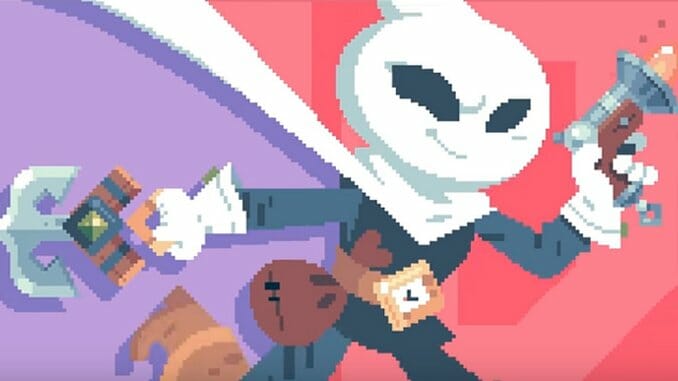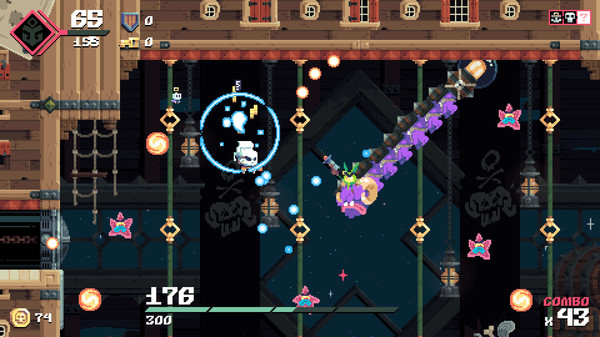
Have you ever gotten your ass kicked in a videogame but couldn’t drag yourself away? That’s how I feel playing Flinthook. I’ve become addicted to the punishing action-platformer developed by Tribute Games, returning to it daily in spite of its challenging obstacles and unrelenting enemy hordes. In particular, the way the game handles progression is a reason why I keep going back. Whether you win or lose, Flinthook always offers the player a sense of advancement, which is perfect for grabbing and holding onto their attention.
Flinthook’s story is about as deep as one has come to expect from a rogue-lite (i.e not very) though that isn’t necessarily a bad thing. Armed with a grappling hook and a device that slows time, you jump from one procedurally-generated spaceship to another, earning upgrades, blasting away enemies and looting treasure. This is easier said than done however, on account of each ship’s hurdles.
As you’ll discover from spending time with the game, every enemy spaceship has a different set of threats that can kill you almost immediately, including space pirates, spike traps and electro-magnetic pulses. These obstacles are extremely difficult to overcome and often appear just as you think you’ve got an area figured out.
You might think this would be ruin the experience, but the distinction is that almost every death in Flinthook is educational, teaching you how to improve your technique for subsequent runs. This is especially true of the bosses in the game, who can be fought after looting the required number of pirate medallions from the smaller spaceships. At first glance, these larger enemies are incredibly intimidating, due to their increased health and their variety of abilities, but they get much easier once you’ve taken the time to learn their movements and locate their weak points.
For instance, it took me a couple of days to beat the first boss: Bad Billy Bullseye. I couldn’t work out how to damage him and my attempts to overwhelm him with plasma balls resulted in a collection of deaths. This forced me to re-analyze my approach and take the time to watch his attacks closely for an opening. It was only after I memorized the trajectory of his projectiles and located the weak spot on his mount’s tail that I finally defeated him, progressing onto a brand new set of challenges.
Beating a boss in this manner is immensely satisfying. It justifies the time you’ve invested into the game, offering you excellent rewards like experience points, abilities, and a brand new bounty to work towards. You’ll also come away with a greater understanding of the game’s mechanics, which you can then use for other enemies that have the same attack patterns.
Then again, you don’t really need to beat the bosses to get some enjoyment out of the game. The hookshot and time-slowing mechanics are robust and prevent the exploration from growing stale, letting you develop your skill and dexterity without forcing you to advance the plot. I’ve personally gotten great pleasure from just messing about with these abilities and trying out more ambitious stunts as I become better acquainted with them over time.
Another thing to mention is you’ll also accumulate experience points to level up by simply playing, permitting you to unlock other fun abilities like hailshots and ricochets from the in-game store. This means that every second you play feels worthwhile, regardless of whether you clear a bunch of spaceships or die trying. The momentum this builds is partly what’s kept me hooked on the game, as I can play either in short bursts or for hours on end and still feel that I’m gradually getting closer to my next goal — whatever that may be.
In addition to the above, there’s also plenty of collectibles to find in each level, like lore items, treasure chests, and relics, which are loads of fun to track down. These give players another objective to focus on, beyond just clearing each stage and beating the boss, and benefit the player in a number of ways.
The lore items, for example, help to flesh out the game’s world, giving neat little insights into the protagonist Flinthook’s identity, while relics and treasure add to your overall experience points earned at the end of a run. Combined, these features give you a pretty solid reason to explore the whole of a ship and deal with further obstacles, before heading to its exit.
That each stage is procedurally generated also helps the player stay engaged. Pretty much every run you make feels just as entertaining and unique as the last, with your environment and weapon strength dependent on whatever’s being thrown your way and the non-playable characters you encounter on your journey. To illustrate, if the player comes across Axelock the Undead, he will give you a random perk at the cost of your max health, whereas other characters will exchange items and power ups for a share of your treasure. These additions guarantee the game never gets tiresome and alleviates some of the difficulty.
Of course, I could talk about a lot of the other stuff that Flinthook has going for it. The soundtrack by Patrice Bourgeault is exceptional, and the 2D character designs are consistently charming. But I believe the game’s biggest triumph is by far the way it encourages you to keep playing, by constantly rewarding you with information, new items and perks.
I’ve played countless hours of Flinthook already, and I can see myself spending even longer trying to uncover all its secrets and upgrades. Flinthook is frustrating, but in exactly the way you want from a videogame. It challenges you to become a better player, and gives you all the necessary tools to hone your skills. That the game can be played in so many styles and by players with vastly different skills truly is a testament to the ingenuity and craftsmanship that’s been poured into its creation.
When not glued to the latest release, Jack Yarwood spends his time writing and talking about videogames online. You can follow what he’s up to on his Twitter and on his blog.


